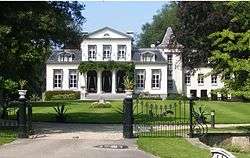Oranjewoud
| Oranjewoud It Oranjewâld | |
|---|---|
| Village | |
|
The buitenplaats called Oranjewoud | |
| Coordinates: 52°57′N 5°56′E / 52.950°N 5.933°E | |
| Country | Netherlands |
| Province | Friesland |
| Population (2010) | |
| • Total | 1,035 |
| Source: CBS, Statline. | |
| Time zone | CET (UTC+1) |
| • Summer (DST) | CEST (UTC+2) |
Oranjewoud (West Frisian: Oranjewâld, literally "Orange Forest") is a small village in Heerenveen in the province of Friesland, the Netherlands. It had a population of around 162 in 2006. It is known for Oranjewoud Palace. The village had one museum called Belvédère.
History


The village is known for Oranjewoud Palace. It was built for the royal family. In 1676 Countess Albertine Agnes of Nassau bought a country seat in the woods as a buitenplaats or summer residence. She was a Princess of Orange, and a widow of the Frisian Stadtholder Willem Frederik of Nassau-Dietz.
After her death, her daughter Princess Henriëtte Amalia of Anhalt-Dessau owned the palace. Her architect Daniel Marot, known for Het Loo Palace, designed a new palace. After that, two wings were built, but the central building was never built.
After her death, John William Friso, Prince of Orange lived in the palace. But he died very early, and his wife, Landgravine Marie Louise of Hesse-Kassel stayed at Oranjewoud. Until 1747 the palace was often visited by the stadhouders. In that time William IV, Prince of Orange lived in oranjewoud. But William V, Prince of Orange also visited the palace one last time in 1777.
Beside Oranjewoud Palace the royal family had another residence called Carolineburg. This was a small castle. Probably it was named after Princess Carolina of Orange-Nassau, who lived there. In 1774 it was demolished.
During the French Revolution the palace was demolished and the estate was sold to the Frisian nobility.
One of them was Hans Willem de Blocq van Scheltinga. In 1834 he built a new buitenplaats on the previously royal estate called Oranjewoud, after Oranjewoud Palace. This new buitenplaats was not longer owned by the royal family, but was still occasionally visited by members of the royal family. King William I of the Netherlands, King William III of the Netherlands and Queen Juliana of the Netherlands all stayed at Oranjewoud.
But Prince Henry of the Netherlands, Prince Bernhard of Lippe-Biesterfeld, Queen Beatrix of the Netherlands and Prince Claus of the Netherlands visited the buitenplaats as well. Today, the buitenplaats is owned by the Friesland Bank.
Another buitenplaats in oranjewoud is called Oranjestein. This one was the former home of the royal steward. The millionaire Pieter Cats bought it and expanded it. Some other existing estates in Oranjewoud are: Klein Jagtlust, Oranjehoeve, Princenhof and Klemburg. Destroyed estates are: Ontwijk, Brouwershave, Veenzigt and Paauwenburg.
Overtuin
In 1953 the estate was sold in two parts by the family De Blocq van Scheltinga. One part, was bought by the government. The Park was designed in French Baroque style. Now the park is owned by the government and is free to the public. Literally Overtuin means 'the garden in front of'.
Museum Belvédère
The museum is a museum of contemporary and modern art. The museum was opened on November 24, 2004 by Queen Beatrix. The building was designed by Eerde Schippers. It is 104 meters long and 13 meters wide. he building was the winner of the contest BNA Building of the Year 2006. The museum is named after the Belvedere in the Park area Oranjewoud. The collection consists mainly of works by Frisian artists, like Jan Mankes, Thijs Rinsema, Tames Oud, Gerrit Benner, Boele Bregman, William Althuis and Sjoerd de Vries.
Famous people from Heerenveen
- Cissy van Marxveldt was born in Oranjewoud in 1889.[1]
Population
| 1954 | 1959 | 1964 | 1969 | 1973 | 2005 | 2006 | 2007 | 2008 | 2009 | 2010 |
|---|---|---|---|---|---|---|---|---|---|---|
| 569 | 541 | 595 | 926 | 862 | 1062 | 1062 | 1041 | 1043 | 1045 | 1042 |
References
- ↑ Henk van Gelder (13 March 2008). "Haan, Setske de (1889-1948)".
| Wikimedia Commons has media related to Oranjewoud. |
Coordinates: 52°56′45″N 5°57′4″E / 52.94583°N 5.95111°E
